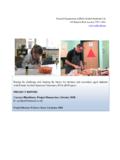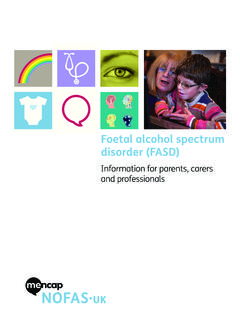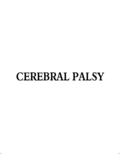Transcription of FASD & THE CLASSROOM 5 AUGUST 2017 …
1 FASD & THE CLASSROOM 5 AUGUST 2017. Teaching a Student with FASD. Equality Act [Schools] must make reasonable adjustments, including the provision of auxiliary aids and services, to ensure that disabled children and young people are not at a substantial disadvantage compared with their peers. This duty is anticipatory it requires thought to be given in advance to what disabled children Dear Teacher and young people might require and You have a student in your CLASSROOM who has a Foetal Alcohol what adjustments Spectrum Disorder (FASD) and needs your help to access might need to be made to prevent that education. Thank you for reading this information. disadvantage.. See: SEND Code of Practice Foetal Alcohol Spectrum Disorders (FASD) is an umbrella term representing the 0-25: Statutory Guidance range of effects caused by prenatal alcohol exposure. Each student with FASD is SENDCode. individual and their learning difficulties and disabilities will depend on the extent of damage caused to the developing organs and brain.
2 This damage results in difficulties for students in many areas of the curriculum in the acquisition of new information, linking new information to previously learned information and the practical application of knowledge gained. Unless otherwise noted 1 2 3 material is excerpted from NOFAS-UK Teacher Toolkit by Project Researcher C. Blackburn and Project Director UNDERSTAND RECOGNISE ACCOMMODATE B. Carpenter. For more information see: http://. FASD is brain damage Know the signs of a Success is possible with TeacherToolkit. The in-depth due to prenatal alcohol child with FASD supports and strategies Primary and Secondary exposure Framework documents are widely used resources. 1 Teaching a Child with FASD Features of FASD. Each student with FASD has a unique profile. There are some features of FASD which may be evident in other disorders and disabilities, but these features can be so pronounced in students with FASD, depending on the severity of presentation, that it is worth highlighting them.
3 Memory/Learning/Information Processing difficulties, including inconsistent retrieval of learned information, being slow to learn new skills, inability to learn from past experiences, problems recognising consequences of actions and problems with information processing speed and accuracy. Planning/Temporal Skills including needing considerable help to organise daily tasks, inability to organise time, not understanding the concept of time, difficulty in carrying out multi-step tasks. Behaviour Regulation/Sensory Motor Integration difficulties including poor management of anger/. tantrums, mood swings, impulsivity, compulsive behaviour, perseveration, inattention, inappropriately high or low activity level, lying/stealing, unusual (high or low) reaction to sound/touch/light. Abstract Thinking/Judgement difficulties including exercising poor judgement, requiring constant supervision, poor abstract thinking, poor understanding of safety and danger.
4 Spatial Skills/Spatial Memory difficulties, gets lost easily, has difficulty in navigating from one destination to another. Social Skills and Adaptive Behaviour including behaving at a level notably younger than their chronological age, poor social/adaptive skills. Motor/Oral Motor Control including poor/delayed motor skills, poor balance, difficulty in feeding (chewing, swallowing and sucking). A lack of clarity in speech may be compounded by cleft palate or palatal dysfunction. Cognition/Academic Achievement, including working at curriculum levels below peers, requiring constant repetition of instructions, rules and subject areas. Language/Social Communication including lack of understanding of social cues, strong expressive language coupled with poor receptive language skills, lack of empathy for others. Communication can also be affected by cleft palate (see above), hearing and hoarseness. Physical symptoms may include distinctive facial features (Foetal Alcohol Syndrome only), small head (microcephaly), small stature, organ damage and skeletal damage.
5 2 Teaching a Child with FASD FASD is a Spectrum - an Invisible Disability . Diagnoses include: Foetal Alcohol Syndrome (FAS) Partial Foetal Alcohol Syndrome (pFAS) . Alcohol-related Neurodevelopmental Disorder (ARND) Alcohol-related Birth Defects (ARBD). The brain develops throughout pregnancy. While only approximately 1/10 of those with FASD. have the facial features of FAS, most with FASD have cognitive impairments. Over 400 conditions can co-occur with FASD. Understand the Root Your Insight Matters Cause of FASD Students with FASD who receive FASD impacts each person differently, diagnosis and appropriate support do students with FASD are complex.' better. FASD can be and is often diagnosed alongside There are a number of secondary disabilities other disabilities such as Autistic Spectrum associated with FASD, the occurrence of which can Disorder (ASD), Attention Deficit Hyperactivity be reduced by a range of protective factors.
6 Disorder (ADHD) Attention Deficit Disorder (ADD) Secondary disabilities include: mental health Attachment Disorders and Sensory Integration problems; disrupted school experience; trouble Disorder (SID). with the law; confinement (for mental health problems, alcohol/drug problems or crime);. Permanent damage to developing organs and inappropriate sexual behaviour; alcohol/drug bones can occur at particular periods of problems. A positive educational experience is pregnancy. Damage to the Central Nervous key. System continues throughout pregnancy and results in changes to the structure of the brain which cannot be reversed and persist throughout life. Transition from primary to secondary education can be particularly difficult for students with FASD. and needs to be carefully managed, to ensure that communication is efficient and services to families do not become disrupted. A full assessment of the students needs should be undertaken at this time.
7 BEHAVIOURS ARE SYMPTOMS. Some children will not present any obvious characteristics of FASD; their symptoms will be purely behavioural. It is important that teachers are aware of the true effects of the hidden impairments, so they can recognise and accommodate children's learning needs. Children with FASD may score within normal limits on measures of IQ, appear physically mature, and give the appearance of functioning at a level consistent with their chronological age. Their expressive language may be in advance of their actual age, and their reading skills may be chronologically appropriate. However, the academic abilities of individuals with FASD are below their IQ level; their living skills, communication skills and adaptive behaviour levels are even further below IQ levels; and in areas such as social skills and emotional maturity, they may be performing at half of their developmental age. 3 Teaching a Child with FASD FASD is Brain-Based IT'S NOT HOW IT MIGHT LOOK My child may look' okay to you, but she tries so hard to hold it together in school all day that she has a sensory meltdown when she Different areas of the brain can be comes home or refuses to come to school.
8 This compromised by prenatal exposure is a symptom of an unmet need due to her to alcohol, affecting different areas disability, not bad parenting.. of learning. 4 Teaching a Child with FASD 5 Teaching a Child with FASD FASD: A Checklist for Inclusion Say the student's name at the beginning of an instruction or sentence. Make sure you have the student's attention before you speak. Make sure you are facing the student so that they can see your facial expressions and gestures. Use simple, concrete and consistent language across the curriculum and throughout the school. Share language for educational concepts with parents/. carers. Think about the language used in tests/exams and whether it matches what the student is familiar with. Give only one instruction at a time. Keep instructions short; use the minimum number of words. Say exactly what you want the student to do ( instead of saying Tidy up , say Put the scissors in the blue box ), and back this up with pictures if necessary.
9 If you are interrupted whilst giving an instruction, go back to the beginning of your sentence. Ensure the student has understood by asking them to repeat an instruction back to you in their own words. Give the student time to think about what you have asked of them. Use positive communication; instead of saying Don't run , say Walk . Use exaggerated facial expressions and gestures to give the student clues as to your meaning. Reinforce auditory input with visual aids and provide students with a visual timetable. Break tasks into small steps and be realistic about expectations. Use visual prompts and concrete objects such as puppets for story telling for young students and number lines for mathematics. Show rather than tell; demonstrate concepts so that students know exactly what is expected. Provide opportunities for discussion of new concepts before they are introduced in the CLASSROOM and check understanding afterwards.
10 Provide opportunities for new learning to be connected to existing knowledge. Communicate with parents/carers regularly by email/phone/home-school diary. Provide worksheets which have plenty of white space and do not mix mathematical concepts and operations. Plan around the student's strengths and interests and provide immediate, frequent praise for each achievement. Be flexible about how achievement is recorded, consider video, photographic evidence and provide a scriber where necessary for technical lessons such as science where the student may be overwhelmed by sensory stimulation. Plan multi-sensory experiences based around the students sensory strengths and needs, including activities involving movement. Remove as many distractions from the environment as possible to enable the student to concentrate on the teacher/task. 6 Teaching a Child with FASD resources - Additional Resources higher-ed-judy-willis Understanding FASD will help you be a Hey Teacher!



